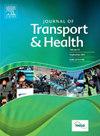Risk perception, protective behavior, and transit ridership during COVID-19: Longitudinal insights from Seoul Metropolitan Area, Republic of Korea
IF 3.2
3区 工程技术
Q2 PUBLIC, ENVIRONMENTAL & OCCUPATIONAL HEALTH
引用次数: 0
Abstract
Introduction
The COVID-19 pandemic heightened individuals’ risk perception and increased their protective behaviors to minimize unnecessary contact with others. While existing studies have explored behavioral changes in response to the pandemic, few have examined the dynamic interplay between risk perception, protective behaviors, and contextual factors, largely due to the limitations of short-term or cross-sectional data.
Methods
This study used 80 repeated cross-sectional surveys conducted throughout the pandemic to track the risk perception and protective behavior of Koreans. We adopted a one-way ANOVA model and a conceptual SEM to examine the differences in risk perception and protective behavior across various socio-demographic groups. The variables considered were individuals’ risk perception, protective behaviors, and the external environment such as the number of confirmed cases and government quarantine measures for exploring their associations with public transit usage.
Results
The results indicate that individuals' risk perception is significantly influenced by their surrounding environment. Individuals with heightened risk perception are likely to adopt preventive measures, which in turn impact their public transit ridership. We also provide compelling evidence on how risk perception and protective behavior related to COVID-19 evolved over time, influenced not only by public health policies but also by individuals’ socio-demographic characteristics. Last, this study empirically demonstrates the occurrence of psychic numbing resulting from repeated exposure to a persistent threat.
Conclusions
These findings underscore the importance of adaptive public health strategies and targeted communication to address the varying perceptions across different socio-demographic groups, contributing to a more resilient public transit system. This study highlights the importance of adaptive transit operations, sustained safety measures, and continuous public engagement during future pandemics.
2019冠状病毒病期间的风险认知、保护行为和过境客流量:来自大韩民国首尔大都市区的纵向见解
2019冠状病毒病大流行增强了个人的风险认知,并增加了他们的保护行为,以尽量减少与他人的不必要接触。虽然现有研究探讨了应对大流行的行为变化,但很少研究风险感知、保护行为和环境因素之间的动态相互作用,这主要是由于短期或横断面数据的局限性。方法本研究采用80次重复横断面调查,追踪韩国人的风险认知和保护行为。我们采用单因素方差分析模型和概念扫描电镜来检查不同社会人口统计学群体在风险感知和保护行为方面的差异。考虑的变量包括个人的风险认知、保护行为和外部环境,如确诊病例数量和政府为探索其与公共交通使用的关联而采取的隔离措施。结果个体的风险感知受周围环境的显著影响。风险意识较高的人可能会采取预防措施,这反过来影响他们的公共交通乘客。我们还提供了令人信服的证据,证明与COVID-19相关的风险认知和保护行为是如何随着时间的推移而演变的,这不仅受到公共卫生政策的影响,还受到个人社会人口特征的影响。最后,本研究实证证明了心理麻木的发生是由于反复暴露于持续的威胁。这些发现强调了适应性公共卫生战略和有针对性的沟通的重要性,以解决不同社会人口群体的不同看法,有助于建立更具弹性的公共交通系统。这项研究强调了在未来大流行期间适应性过境操作、持续安全措施和持续公众参与的重要性。
本文章由计算机程序翻译,如有差异,请以英文原文为准。
求助全文
约1分钟内获得全文
求助全文

 求助内容:
求助内容: 应助结果提醒方式:
应助结果提醒方式:


